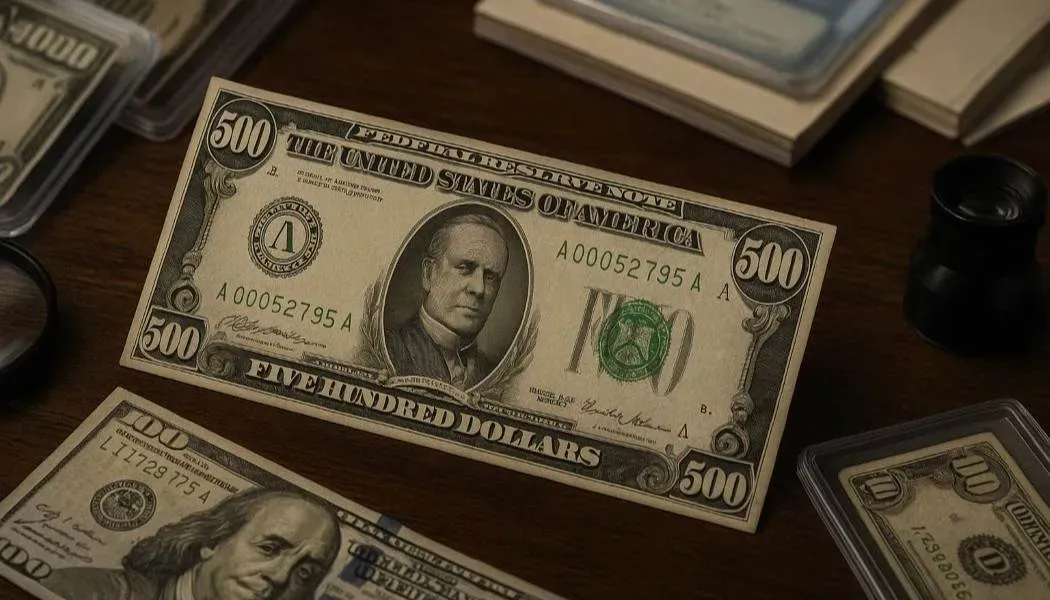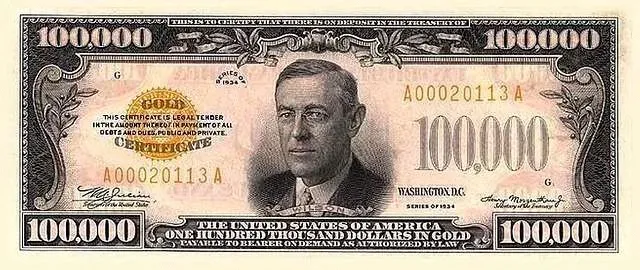
A Forgotten Giant of U.S. Currency
Among America’s most captivating pieces of paper money is the $500 bill, a denomination long retired from daily commerce but still treasured by collectors. Though the Bureau of Engraving and Printing (BEP) last printed them in 1945 and the Federal Reserve officially discontinued them in 1969, these notes remain legal tender. Today, however, their worth extends far beyond face value, representing a prized link to the history of U.S. banking and monetary policy.
From Early Issues to Iconic Designs
The $500 bill traces its beginnings to the late 1700s, when states like North Carolina and Virginia released high-value notes of this denomination. Over the 19th century, a series of designs appeared, featuring notable leaders such as John Quincy Adams, Joseph Mansfield, Charles Sumner, and even Abraham Lincoln.
Perhaps the most celebrated issue was the 1918 Blue Seal note, portraying Chief Justice John Marshall on the front and Hernando DeSoto’s discovery of the Mississippi River on the back. Later, starting in 1928, President William McKinley became the enduring face of the $500 bill. These McKinley notes remain the most familiar and widely collected, with well-preserved examples often selling for thousands.
Why High-Denomination Notes Existed
Bills like the $500, $1,000, $5,000, and $10,000 were never intended for pocket change. Instead, they served as banking tools, facilitating the transfer of substantial sums between Federal Reserve banks. In the days before wire transfers and electronic systems, these notes were an efficient way to settle large transactions.
The $500 bill represented the “entry level” of these large denominations, while the $100,000 Gold Certificate—depicting Woodrow Wilson—was the largest ever issued, though it was reserved strictly for government transactions.
Decline and Withdrawal of the $500 Bill
The utility of large notes diminished after World War II, as advances in electronic banking made them redundant. At the same time, authorities feared that high-value bills could be exploited for money laundering, tax evasion, or organized crime.
Production of $500 bills ceased in 1945, and in 1969 the Federal Reserve formally withdrew them from circulation, citing lack of practical use. Their retirement marked a turning point, as digital systems took over the role once played by physical high-denomination paper money.
Are $500 Bills Still Spendable?
Yes, the $500 bill is technically still legal tender in the United States. However, using one to buy groceries or pay a bill would be a costly mistake. Collectors and investors routinely pay far more than face value for these scarce notes, with prices running into the thousands depending on rarity and condition.
More than currency, each note represents an artifact of artistry and history. The engraved portraits, detailed reverse scenes, and distinctive seals reflect an era when craftsmanship was integral to U.S. banknotes.
Collector Market and Auction Highlights
While every $500 bill carries an official face value, the numismatic market tells a remarkably different story. Condition, issue, and rarity all play critical roles in determining price.
- 1918 Blue Seal $500 Note – In 2019, a Gem Uncirculated 66 PPQ example sold through Heritage Auctions for $180,000, a record price for the denomination.
- 1934 $500 Federal Reserve Note – In 2024, a crisp note discovered tucked inside a family Bible realized $20,000 at auction.
- Circulated Examples – Even well-worn McKinley notes often bring $3,000–$5,000, with exceptional pieces commanding significantly more.
These sales demonstrate how scarcity and condition drive demand, making the $500 bill a staple of rare currency auctions.
Why the $500 Bill Still Captivates Collectors
Although obsolete in the banking system, the $500 bill retains enduring significance. For numismatists, owning one is about more than profit—it is about holding a tangible piece of America’s financial evolution.
From its origins as a banking necessity to its present status as a collectible icon, the $500 bill bridges the past and present. Each surviving note speaks to an era before digital transactions reshaped the financial world, offering collectors artistry, rarity, and a direct connection to history.
FAQ: About the $500 Bill
Was there ever a real $500 bill?
Yes. The U.S. issued them from the 18th century through 1945, with the most common series featuring President William McKinley.
Why was the $500 bill discontinued?
It was retired in 1969 due to declining use and concerns about criminal activity, as electronic transfers replaced high-denomination notes.
How much is a $500 bill worth today?
Most sell well above face value. Circulated examples typically bring $1,000–$5,000, while rare or uncirculated notes can command far higher premiums.
Who appears on the $500 bill?
The best-known version features William McKinley, though earlier issues depicted figures such as John Quincy Adams and John Marshall.
What is the rarest $500 bill?
The 1918 Blue Seal note is among the most coveted, especially in top condition, with auction prices reaching six figures.
Can I still spend a $500 bill?
Yes, though doing so would be unwise since collectors pay thousands for them.
Where can I buy or sell one?
Trusted dealers, major auction houses, and numismatic shows are the safest venues. Authentication by PMG or similar services is recommended.
Why do collectors value these bills?
Their rarity, artistic design, and place in U.S. currency history make them unique and highly sought after.
Continue Your Numismatic Journey:
Want to explore more about rare currency, precious metals, and collecting strategies?
Visit the Bullion Hunters Learning Center for expert guides and resources designed
to help you build knowledge and confidence as a collector or investor.
Another article that may interest you:
The US $1000 Bill: Rarity, Legacy & Collector Value

